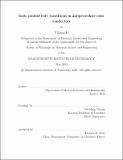Ionic conductivity transitions in antiperovskite ionic conductors
Author(s)
Li, Yiliang
DownloadThesis PDF (11.90Mb)
Advisor
Chiang, Yet-Ming
Terms of use
Metadata
Show full item recordAbstract
High-performance solid electrolytes are critical for realizing all-solid-state batteries with enhanced safety and cycling efficiency. However, the relatively low ionic conductivity of most solid state electrolytes has been considered as the major challenge. Antiperovskite(AP) electrolytes are recently developed solid state electrolyte with enhanced ionic conductivity. AP materials also provide an ideal system to study the relationship between disorder and ionic conductivity, as in AP system the degree of lattice disorder can be easily tuned through atom substitution and the incorporation of cluster ions. Moreover, some AP compounds exhibit non-linearity in the Arrhenius plot of ionic conductivity. At higher temperatures, ion conductivity of AP materials curve upward, while most of the known solid electrolytes exhibit negative deviations. This thesis outlines study on the mechanisms of such ionic conductivity transition in APs and aims to give guidance on design of solid electrolytes with high ionic conductivity, including octahedral tilt disordering, paddlewheel mechanism and double paddlewheel mechanism. Carrying out temperature-dependent synchrotron XRay diffraction, differential scanning calorimetry, impedance spectroscopy, neutron diffraction, nuclear magnetic resonance and ab initio molecular dynamics simulation, we show that the 100x increase in ionic conductivity in stoichiometric AP Na₃OCl is related with an octahedral to cubic phase transition with increasing octahedral tilt disorder. We then present two novel cluster ion AP electrolytes Li₂(OH)Cl and Na₂(NH₂)(BH₄) in which paddlewheel and double paddlewheel mechanism with high cation vacancy concentration result in more than 100x ionic conductivity increase through the phase transition. Our study suggests that to achieve high ionic conductivity in solid electrolytes, a structure with octahedral tilt disordering, high vacancy concentration and cluster anions with high rotational mobility are beneficial.
Date issued
2022-05Department
Massachusetts Institute of Technology. Department of Materials Science and EngineeringPublisher
Massachusetts Institute of Technology